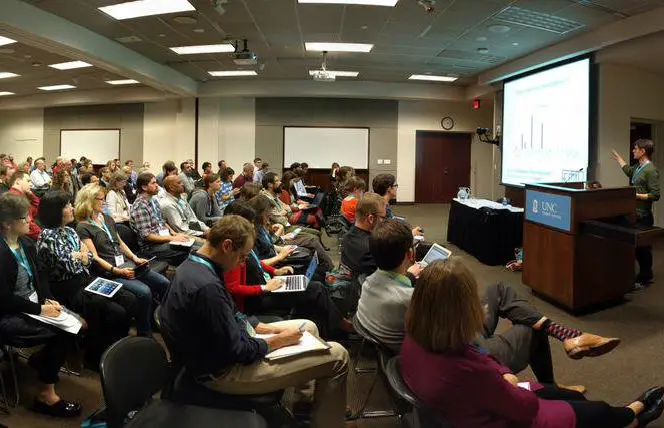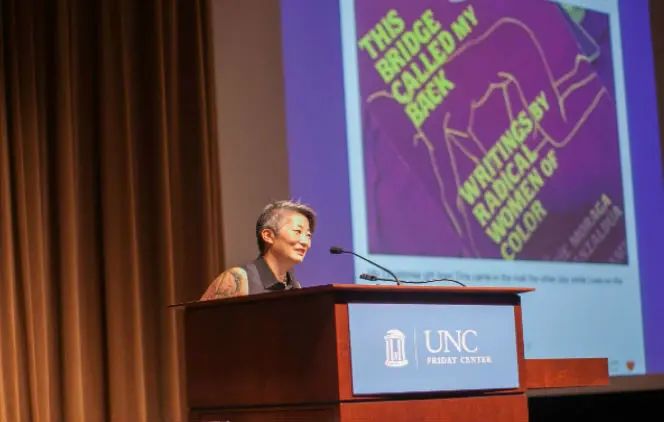iPRES 2015: The 12th International Conference on Digital Preservation
This blog was written by Andrea Byrne (Digital Preservation Process Administrator at Archives New Zealand) and Jessica Moran (Digital Archivist at the Alexander Turnbull Library, National Library of New Zealand).
In early November last year we were fortunate enough to attend the recent 12th International Conference on Digital Preservation (iPRES), hosted by the School of Information and Library Science and the Odum Institute for Research in Social Science at the University of North Carolina at Chapel Hill.
The conference is held annually and rotates between Asia/Oceania, North America and Europe. This year’s conference had about 300 attendees, mostly from across the United States, but there were also significant numbers of attendees from Europe, Asia, Australia and of course there was us two from New Zealand.
Though it already feels like ages ago, we both thought the conference was particularly useful for us, as many of the participants were digital preservation practitioners. And those practitioners, whether their organisations have well established digital preservation workflows, or were just getting started, face many of the same issues we do.

Attendants of the iPRES conference 2015
Digital preservation is not solved. Yay!
So the good news is, digital preservation and the long term preservation of born digital objects is not solved and we can continue to have many more iPRES conferences to talk about policy, engagement, ways to provide access, and getting those born digital files from agencies and donors and into a preservation system for years to come!
Even with the two of us attending, it was impossible to hear all the presentations or attend all the tutorials, workshops, and other events. However there were a few themes that arose for us, one of which was organisational assessments.
While digital preservation is still a young field, there are more efforts to assess what exactly we are doing and how successfully we’re doing it. This topic continued to bubble up at the conference in workshops, papers, and posters.
Better, more accessible storage
Digital preservation storage was another popular topic this year. A panel with representatives from a number of U.S. organisations either offering, or about to offer, digital preservation storage services for institutions was informative.
These organisations are providing dark archives services with bit-level digital preservation.
This was a great opportunity to hear about the progress of these programs, the technical specifications behind them, and the work they do with their member organisations or clients.
It’s especially heartening to hear that there may soon be more digital preservation options available to smaller institutions which might not otherwise be able to fund a full digital preservation programme.
The funding of long term digital preservation storage was also addressed in both a paper from MetaArchive and a poster from Chris Erickson and Barry Lunt of Brigham Young University.
A paper by Joey Heinen and Andrea Goethals from Harvard University on developing a file format migration framework was especially interesting because, at the National Library, we continue to explore file format migrations with some of our born digital collection material in essentially obsolete file formats like Wordstar and Wordstar 2000.
The continued development of a framework and workflows for format migrations will help us to improve our own processes and thinking.
Getting our hands dirty in the best way
This year’s iPRES conference made an extra effort to foster frank and engaging discussions around these issues and many more. For example, there was a Policy and Practice Documentation Clinic, where we weren’t lectured to about policy, but instead attendees talked in small groups about the challenges of creating and implementing policies at our institutions and discussed what makes a good or bad policy.
Notes from the Policy and Practice Documentation clinic can be found here.
Another new feature iPRES implemented was encouraging participants to contribute to notes from the sessions and workshops by hosting collaborative documents on Google Drive.
The iPRES organisers also had a series of ‘Get a Room’ sessions, where conference attendees put forth ideas for topics to discuss in a given timeslot, and space was allocated in response to voter input. These proved popular among attendees and were a great way to share ideas and practices.
These informal discussions with other digital preservation practitioners and digital archivists in the ‘Get a Room’ sessions and in the ‘Using Open Source Tools to Fulfil Digital Preservation Requirements’ workshop were conference highlights for us.
Workshop and tutorial notes from the conference can be found here.
The job title and responsibilities for ’digital archivist’ or ‘digital preservationist’ have grown rapidly as a specific practice and a body of people in the last few years. It feels like there are finally enough of us with enough experience to have substantial conversations about our practices.
There might not be any universally agreed-upon best practices yet, but we are able to talk about what good practice looks like.
Having these conversations with other digital archivists and digital preservation practitioners at iPRES is invaluable for developing not just our networks, but also our thinking about digital preservation and the practice of working with born digital collections.
Inclusiveness at conferences - we're getting there
On a final note, there appeared to be a strong effort to include more voices from women in the digital preservation community.
A number of conferences with a technical leaning are starting to recognise the ways women are often talked over, ignored, and harassed, even within professional communities, and are trying to figure out ways to reverse that trend.
One method some conferences employ (but iPRES did not) is establishing a code of conduct and/or anti-harassment policy. Even though a code of conduct was not established, a large number of the talks were presented by women and both keynote speakers were women.

Keynote speaker Lisa Nakamura at the iPRES conference 2015
Lisa Nakamura, one of the keynote speakers, gave a talk called ‘The Digital Afterlives of This Bridge Called My Back: Public Feminism and Open Access’ about how people are using Tumblr to curate memories and facilitate distribution of the seminal feminist text about radical women of colour, This Bridge Called My Back, which was out of print until 2015.
Beginning Wednesday morning with a woman of colour discussing the intersections of feminism, race, technology and open access activism, hopefully helped to encourage a more inclusive conference culture.
We both came back from the conference refreshed and stuffed full of ideas to share.
There are a lot of exciting new tools and projects in development, like National Archives of Australia’s ‘Project Chrysalis’, which, if all goes to plan, will provide an end-to-end solution to getting digital records from an agency.
Digital preservation may not be ‘solved’ but with avenues open to contribute and collaborate, there are plenty of opportunities to work together to find better methods and solutions within our institutions and beyond.
Thanks Jess - good to get that detailed feedback. Such an important field for us.